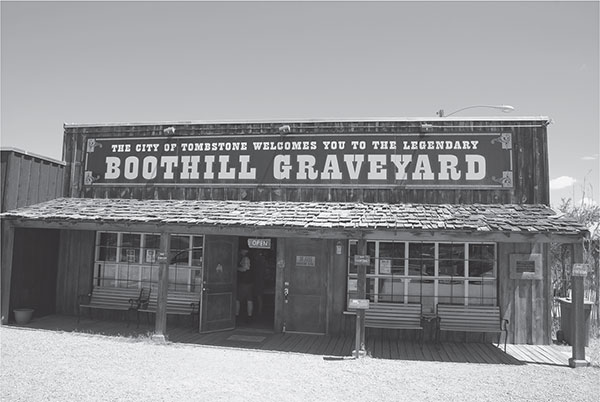
The gift shop at Boot Hill. Originally, this was the entrance to the graveyard. Wikimedia Commons.
6
BOOT HILL GRAVEYARD
Boot Hill was not the first cemetery in Tombstone. In fact, two others preceded it. The first was located about a mile south of town near the Grand Central mine. However, it was only in use for a short period, as mine tailings encroached on it and started covering some of the graves.
In 1879, the second cemetery was established just north of town on Fremont Street. This graveyard was about the size of a city block. Although this was empty space back then, today, the boundaries of this graveyard run north to south between Bruce and Safford Streets. Its east–west boundary was from Sumner to First Street. Today, this is the block where the local Circle K convenience store stands. A resident in Tombstone described this cemetery in 1891, recalling that several graves were enclosed by fencing and that there was a Masonic section.
Within a year, a new extension of this cemetery began toward the north on top of the hill. This left a vacant area without graves sitting between the two. After this expansion, the older area began to fall into disrepair and was ultimately abandoned in preference to the newer northern section.
Much later, Tombstone was reminded of the area’s history as a cemetery when houses were being built on top of it. The excavations for new housing dug up several grave residuals and a few skeletons.
The cemetery on top of the hill is now all that remains. It was in use from about 1880, and within a few months, it had a multitude of grave sites. The McLaury brothers and Billy Clanton were buried here after being shot dead at the O.K. Corral gunfight. It is also quite organized with specific sections. It has a Jewish area on the northeast side of the hill and a Chinese space designated at the very north end, just beyond the boundary fence of today’s Boot Hill. The Catholic section kept growing larger and eventually expanded toward the west.

The gift shop at Boot Hill. Originally, this was the entrance to the graveyard. Wikimedia Commons.
However, Tombstone was growing, and new homes were being built closer and closer to the cemetery. The town government soon erected a new cemetery on the end of Allen Street and closed the graveyard on the hill on May 31, 1884. After that, the cemetery on the hill was merely referred to as the old cemetery.
This old cemetery became neglected as the years passed. The townsfolk eventually forgot about the graves and began using it as a dumping ground for debris. A few people knew of its existence but had forgotten its name. They simply referred to it as the little cemetery on the road to St. David.
The eventual restoration of Boot Hill began in 1923 with a man named Frederick Bechdolt. He was an author who had written several books on the Old West. While researching some of the local history and lore in Tombstone, he visited the old cemetery on the hill. He was appalled at the condition of the graveyard. Covered in the discarded trash, it was almost impossible to discern where any specific graves were. The only one that was still obvious was a gravestone with the name “Martin Peel.” It was disconcerting to him that this part of history had not been preserved and was practically forgotten.
He reacted by writing to the editor of the Tombstone Epitaph, expressing his shock and disgust that the cemetery was desecrated and in such a state of disarray. He wrote to the local paper, emphasizing how “the historical and practically only remaining Boot Hill Cemetery in the West, was being neglected.” This was the first time that the old cemetery was referred to as Boot Hill. The letter soon reached city hall, where it attracted a great deal of interest.
In 1925, the town acquired the assistance of the Boy Scouts to help clean up the graveyard. Another local man, Harry Macia, located several of the burial sites, including those of the McLaurys and Billy Clanton. There he erected a marker that read “Murdered on the Streets of Tombstone.”
Bechdolt was still involved and returned in May 1925 to speak at the Tombstone Luncheon Club. His speech emphasized preserving the history of the cemetery, and soon afterward, more people came forward to volunteer their help. A local surveyor donated his time to locate the boundaries of thegraveyard to be fenced in, and a fund was created to assist with the costs of clean-up and for a formal restoration plan. Although there was a lot of talk, the action was occurring at a much slower pace. Eventually, the interest in the old graveyard on the hill grew again, which can be seen in this short article published by Tombstone Epitaph on April 4, 1928:
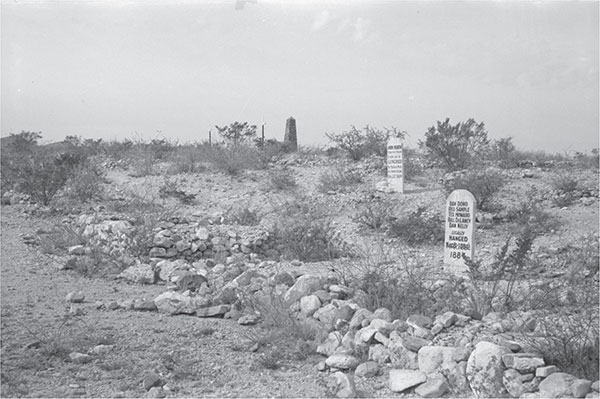
Boot Hill in 1940, before the construction of the gift shop. The crosses in the center of the photo were once streetlights that were donated during the early restoration efforts. Library of Congress.
It may be no more desirable than possible to whitewash the picturesque sins of some of the buried on Boot Hill. Halos and white robes would rest incongruously upon those wide hatted gentlemen of the flaring mustachios, the fierce eyes, and nervous trigger fingers. But at least the stones that cover them can be whitened. There they are, mound after mound row, the graves of old Tombstone’s unknown. Roughly oblong heaps of earth and rocks, scores of them, 150, or 200, or even more of them. On a few, wild thorny shrubs have taken root. Stones litter all. Rocks are banked on the graves. Even the Earth is flinty, rough, barred, and grim. Forbidding is Boot Hill graveyard wherein lie the men who died with their boots on. Not a headboard, not a nameplate, nothing to identify any grave on all Boot Hill. Heavens above, could anything be more horribly symbolic? Here they lie, the bones of the gunman, the stage robbers, the cattle rustlers, the gamblers, painted Jezebels of the “cribs” and the dance halls. Yes, and among the lot may not lie a few others, people who died forlorn and friendless but were decent and self-respecting. The innocent suffer from the sinful with whom they are linked in life. And death also, at least on Boot Hill. Not a blade of grass in this Boot Hill graveyard. Not a flower nor a tree, nor anything soft, lovely and tender. Nothing but the barren ground rocks, thorny shrubs. Everything hard, flinty, drab, hard, ugly, sinister like the lives of most of those whose bones lie under the stony mounds that almost touch so close are they. There is a saddening appropriateness about it. All those lively, vigorous, brave, reckless, hard-hitting, hard-living, hard hating men and women who helped put color and life in the Tombstone of the early 80s have come to this. Nameless skeletons, side by side, row on row, on a stony, desolate hill.
“Live hard and dangerously,” said Nietzsche, the German philosopher. These people did, and see what came of it.
Here are the “self-expressionists” of early Tombstone. Here is the “live your own life” crowd. Here is the jazz gang of the 80s who lived by their wits, or their six-shooters for their sex appeal. Here are the men of hot heads and soft hands, who would rather shoot it out than work it out or reason it out. Here are the boys who would rather take it from the other fellow by force than earn it. Here is the saloon gang adhere and the dancehall habitués. Men and women who lived gaudy lives and were snuffed out.
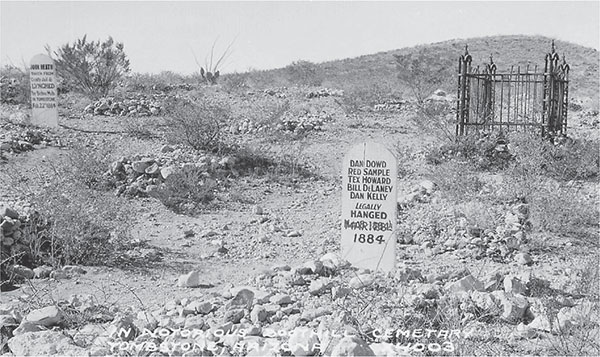
An early photograph of the graveyard taken during the late 1930s. Library of Congress.
In 1932, Highway 80, the “Broadway of America,” was being constructed through Tombstone. In an odd twist of fate, the new highway actually cut through a part of the historic cemetery. Several graves were unearthed, and the occupants of the graves were quietly relocated to the new cemetery at the end of Allen Street.
Once the highway was completed, the town council knew that Boot Hill would be a great tourist stop. In 1933, the highway department gave permission to the town to construct a byway to the graveyard, which was identified by a six- by twelve-foot black-and-white sign that could be easily seen and photographed by passing tourists. It’s new identity as a tourist attraction revived interest in the old graveyard. On April 6, 1933, the Tombstone Epitaph published this article.
Fifty years ago, Frank Vaughn, who has been a resident of Tombstone at intervals since that time and is again residing here, painted a wooden marker for the plot in Boot Hill cemetery where are buried McLowery [sic] and the Clanton brothers. The marker long since crumbled under the rays of the Arizona sun and a cross has been identifying the place during recent years. Now, under the plans of the Chamber of Commerce for improvements at Boot Hill, Mr. Vaughn is to reproduce the marker in form and wording. Other changes are to include a marker of wood for the five Bisbee murderers hanged under the law by Sheriff ward and a clearing of a driveway around the outer edge of the plot outside of the Escapule fence.
The restoration was still underway in 1933 and resulted in several exciting discoveries about the cemetery. As it turns out, the graveyard was much more massive than initially thought. An article in the Tombstone Epitaph on April 18, 1933, described what was discovered:
During the week, Dewey Chadwick, who has been in charge of a crew of workmen engaged in clearing and cleaning Boot Hill graveyard, counted the graves and found there are 259 outside of the drift fence, besides 17 excavations from which bodies have been removed. There may be seen here a small grave marked by a tumbledown stone bearing the name “Sam Harris.” This is the only remaining grave in what was once the Jewish section of the cemetery, originally surrounded by an adobe wall. The wall long since disappeared without right or authority and the bodies all have been removed to other resting places with this one exception. On Monday, Harry Hughes, at work here, dug up a monkey wrench of antique design. It gives every evidence of having been buried beside one of the graves for approximately 50 years. It has been added to the collection of curios and the Chamber of Commerce offices.
However, the popularity of Boot Hill soon began to threaten it, as souvenir hunters secretly carried away headstones and funeral markers. The graveyard was in need of a caretaker and some kind of fencing to protect the site. The fencing was erected out of branches of the ocotillo plant, which created a natural barbed wire fence that would deter the would-be robbers. The position of caretaker would be paid by concessions to be made from those who visited the graveyard.
In the 1940s, Emmett Nunnelly, a resident of Tombstone, began a significant effort to restore the cemetery to its original state. Harry Fulton Ohm, the owner of the Bird Cage Theatre, donated new steel markers from his plant to replace the wooden ones, which were already showing signs of decay. These are the same markers that remain in the graveyard today.
It is important to know that all of the graves are not marked in their exact locations. In fact, some of the graves could be from a couple of feet, one way or the other, but most are quite close to their exact location. Over the years, Boot Hill has been extensively studied and the graves not already marked with a headstone have been remarked as close to their original places as possible by using city records and charts.
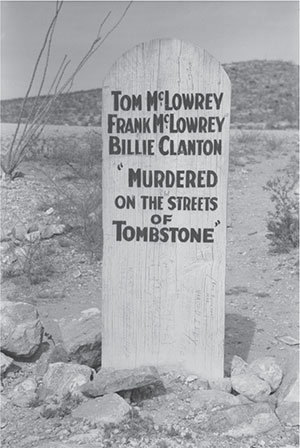
The marker for the victims of the O.K. Corral gunfight in 1933. Library of Congress.
Boot Hill has also been suggested as a possible location of hidden treasure. The August 2009 issue of Lost Treasure told of a small fortune of stolen loot that many believe is buried in or near the grave of Dutch Annie. The story goes that the Can Can restaurant was famous in its day for its food. It sold lobster and imported fish from Mexico and had a hired hunter who kept the café supplied with fresh meat. It was this man who stole a significant sum of money from the Can Can and was later caught. He said he buried the score not far from Boot Hill, but it was never found. The bandit died in jail before he could reveal the location.
Of course, there are also the mysteries of the paranormal type. Visitors often report seeing strange lights and hearing unidentifiable noises coming from the old graveyard. With many reports of human-like shadows lurking from behind the bushes and misty figures ascending up from the graves as well as photos of unexplainable figures of people, no one really knows who these ghosts are or why many of them are there. Billy Clanton, who was killed in the Gunfight at the O.K. Corral, is said to rise from his grave before walking along the road back to Tombstone.
The manager of the Boot Hill Graveyard, Teresa Benjamin, tells people of her accounts of poltergeists and apparitions in the cemetery. She said the sweatshirt rack in the gift shop rotates on its own, money has gone missing and she has seen apparitions in photos taken of the graveyard. Pictures of Billy Clanton’s tombstone are frequently reported to have unexplainable apparitions. Clanton was killed in the gunfight in 1881.
During the decades that I have spent investigating the paranormal claims of the town too tough to die, I have heard my share of strange stories about the old cemetery. However, this is one that I have always found fascinating. It was told to me by a woman named Linda during a ghost-hunting retreat being held in Tombstone. This is her story:
My paranormal experience at Boot Hill was the most intense encounter that I have ever had. I would consider myself a “sensitive” of sorts. This often manifests as sudden dizziness that is followed by seeing something or someone that is indistinguishable move across a room. Almost like a shadow, but there is more substance to it. Occasionally, there are also unexplainable smells, like cigarette smoke in a place where there was no smoking allowed. Nothing real intense or tangible but like a perception of that odor.
This was my first trip to Tombstone, and my husband joked on the drive that I would probably be having some sort of physic experience every ten minutes during our stay.
Surprisingly, it was not that bad at first. The ghost hunting conference probably distracted me to some degree, and I had very little noticeable disturbances. That evening, the conference took us on a ghost tour through the town. One stop on this tour was the Boot Hill cemetery. Again, I really didn’t feel anything. I have to admit that I was a little disappointed but there was always the next day since we had decided on spending the entire weekend there.
The following morning, we got up early and drove back out to Boot Hill. During the tour, it was closed, and the group was not allowed to go inside. I was anxious to see the grounds and to take photos of some of the more famous gravesites. After all, how can you come to Tombstone and not see Boot Hill!
We arrived way too early. The Visitor Center was not even open, so we decided to get out of the car and walk around the graveyard fence for a while until it opened. We were about fifty feet or so away from the parking lot when I noticed an Asian woman in a red dress walking around inside the graveyard. She seemed to be moving from one grave to the next, stopping and bending down for a brief moment before moving on again. At first, I thought that she was pulling weeds, picking up trash or perhaps putting something on the graves. This was when my husband saw her and remarked that the staff was probably out this early because it was safer to work early due to the rattlesnakes. Assuming that someone had arrived to open the Visitor Center, we started back. Just as we approached the parking lot, another car arrived, and a woman stepped out. She locked her car and went to open the front door. Walking to the entrance of the visitor center I suddenly felt dizzy and had to stop for a moment to let it pass. At first, I thought nothing of it, and we walked into the Visitor Center and looked around. My husband decided to talk to the lone employee there about the snakes. While she did acknowledge that there have been sightings of rattlesnakes in the graveyard, she seemed confused when he mentioned the Asian woman that we had seen just moments earlier. She told him outright that she was the only one here and that there should not be anyone walking around outside. Naturally, we were suddenly curious about the person we had just seen outside. We left the gift shop and went into the cemetery. In general, I like cemeteries. They’re peaceful and beautiful, and I enjoy the history. My husband and I walked the rows of grave markers and read from the pamphlet that described how the residents of the cemetery met their demise.
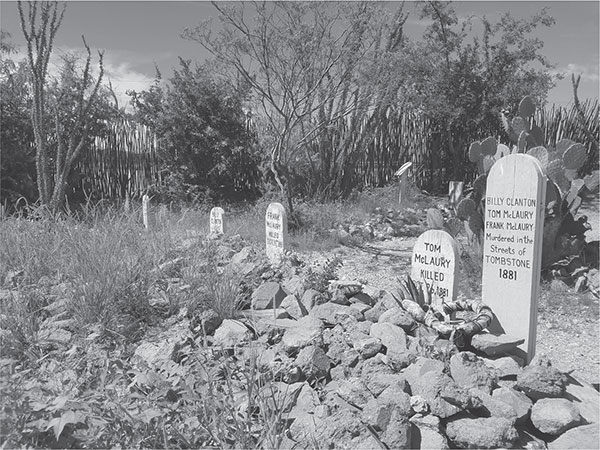
The marker for the victims of the O.K. Corral gunfight as it appears today. Photo by the author.
The side that was closest to the parking lot contained many of the graveyard’s famous residents, and it was quite enjoyable; however, as we walked around we looked for the Asian woman, who was nowhere to be found. Then as we started to move across, I suddenly felt dizzy and out of breath. Halfway across the graveyard, I had to give my husband the pamphlet to read from because I felt weak and disoriented. We turned and headed towards the top of the cemetery. I looked over at the headstone that belonged to someone called China Mary. Just as I started to read what was written on the pamphlet, I suddenly felt a turbulent wave crashing over me. I felt out of breath and had to kneel down. My husband was concerned, but I kept telling him I was okay. I just needed a minute to catch my breath. He gently teased me about angering the spirits and suggested that we should go. I told him that I was fine, and we moved to take a closer look at China Mary’s grave.
Suddenly the dizziness hit like a wave again, churning. I felt like I was body surfing without the rest of my body. With each step, breathing became painful and difficult. I felt like someone was standing on my chest as there was this strange pressure. I am confident that it was not a medical situation. I had drunk plenty of water. I had opened a bottle on the way to the cemetery and finished it while walking around waiting for the Visitor Center to open. However, I have had enough. This was completely overwhelming. We started walking back towards the exit. With each step in the opposite direction, the feelings decreased by half. I took a handful of pictures there but haven’t found anything unusual in them.
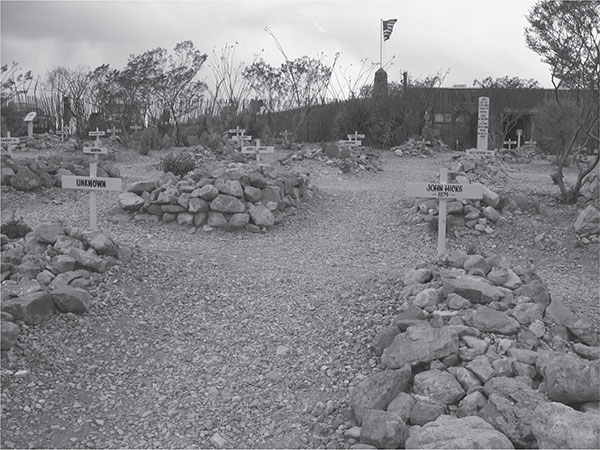
This photo was taken from a similar viewpoint as the 1940 photograph. A comparison between the two is very interesting. Wikimedia Commons.
My gut feeling is that I was sensing China Mary’s spirit. She was a significant figure in Tombstone’s history and a compelling woman. I knew nothing about her until this happened and I had researched some more information about her on the internet. According to something I had found online, she died of heart failure. So I guess that would explain the heaviness in my chest. Part of me really wanted to keep walking and see how far the experience would go. Could I pick something else up? But under the circumstances I just couldn’t. The bizarre thing was that we never found out who the Asian woman was that we saw in the graveyard earlier in the morning. Perhaps it was the apparition of China Mary herself.
While I will admit that I am not a massive advocate of psychics and mediums, this is the fourth instance where I had witnesses describing an Asian woman in a red dress. Three of the sightings were during the daylight hours; the other was just after sundown. All four also had some sort of element that involved dizziness or the feeling of some kind of pressure on their chests. Is this really the restless spirit of China Mary or perhaps something else?